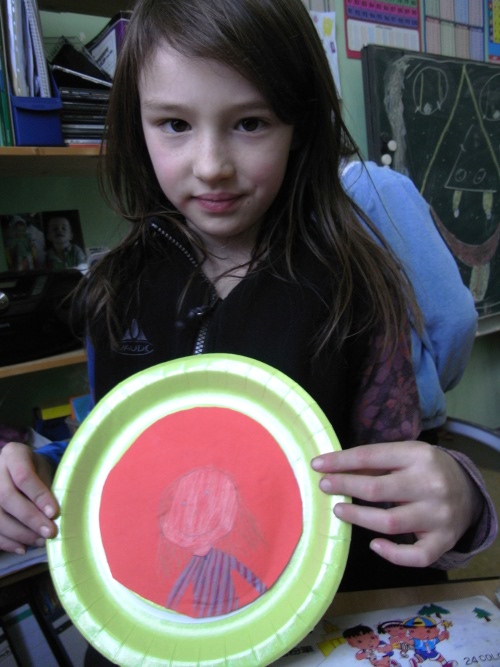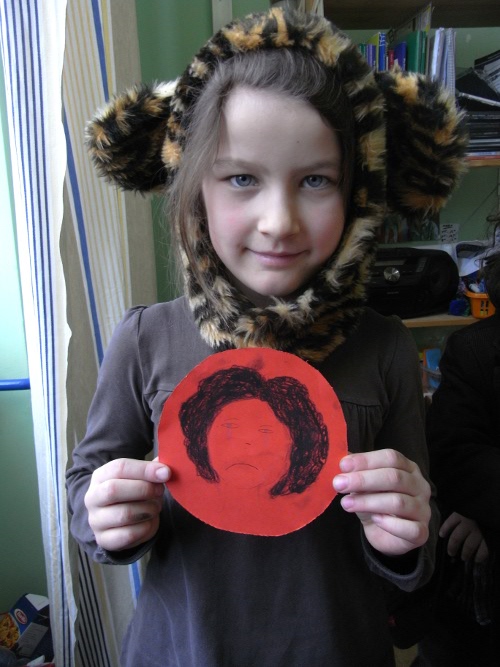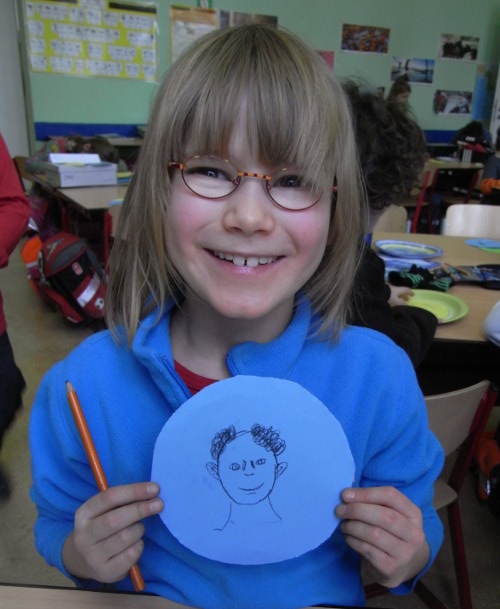Why do we need to study art at all?

I proposed to help run an art class in our school while the art teacher was sick.
To get to know the kids better, I chose the theme “portrait”. I brought with me lots of colored paper cut into circles, and disposible plates to serve as frames. I proposed to the kids that they draw a portrait of anything they chose: animal, monster or person.
I would say that the kids in our class were scared! They were coming to me and asking for precise instructions — they didn’t believe that they actually had the freedoom to choose what to do.
Some kids were saying to me that they “don’t know how to draw” or that they were “bad at drawing”.

In order to overcome this hesitancy, I proposed to start by drawing a portrait together. I started myself and invited anyone who wanted to to join me.

Immediately lots of kids wanted to join. It is not as scary to draw one detail… this is more like commenting on somebody else’s drawing.

Soon, we took over the whole blackboard.
I would say that we had fun. However, the kids did not believe that this fun would last.
“We are just playing and having fun! Is this for real?!”
I was wondering — what did they think art was about? Is it about suffering? Or maybe being bored?

Over the course of the lesson we created hundreds of drawings. Kids took them home and even gave some to me as presents!
There was lots and lots of great, funny, scary and creative stuff.

When I was telling the children that I was seriously thinking of them as great artists and that I liked what they did, almost nodoby believed me. They shook their heads, as if to say, “Oh, you are just a nice person and want us to feel good.”

Yes, I am a nice person, and I believe that to feel good, love art, and enjoy what they are doing should be our goal for our children in art class, but I also seriously thought that what they were doing was great! The pictures were very sincere and funny.

Some were even dramatic.

And almost everybody loves to be filmed, loves to discuss their artworks — that is, if it is really their own artwork and they are choosing what it is about and how they go about doing it.
We continued to draw together, like in the beginning of our class. I would proudly say that I got a very good reputation as an artist. Especially among the girls, whom I was helping to draw princesses.
But I was interested to think about what they meant by “good artist”. They were saying, “You can draw quickly,” or “You can draw realistically”. Maybe I am wrong, but it seemed to me that most of the kids were not used to adults drawing with them and for them.
I would compare this experience — studying art together with adults who never draw — to studying music together with a person who is not able to play themselves, but instead reads instructions from a book and asks the student to play exercises.

The biggest danger of teaching art in the wrong way is the removal of context.
Children no longer understand what is good and what is bad, since they are trained to think that they cannot trust their own feelings (as in, “Not everything that is fun and interesting is good for you!”). Their own system of values is coopted.
So great art is like Van Gogh! But why is Van Gogh a good artist? Was he successful? Was he happy? Is it because his paintings cost a lot of money now and we can see him in every museum?
Would it be enough for you or me just to imitate Van Gogh to get our work in a museum?


This was the beginning of a drawing of a Russian policeman by a boy who said he wanted to draw it for me. At first the policeman was bald, with a lot of medals and decorations.

Then later he got a hat. The boy came often to ask me things like, “So, you’re saying I can draw a monster next? What happens if I draw a butterfly? Is it allowed to not draw at all?” He never seemed to believe my answers.

Daniel Pennac, a French writer who has done a lot of work to popularize reading among kids, put it well when he said that children’s first right, when it comes to reading, is the right NOT to read if they don’t want to.

Why is it so important to me that Benjamin’s art class should be taught in the right way? I understand that children are especially vulnerable in comparison to adults, and at this particular age, they are at the time in their lives when most people lose the ability to draw. In many cases, this happens because the criteria for what “good drawing” is are stated (or understood) as things like “drawing like an adult” or copying “good drawing”.

From an early age, Benjamin has been exposed to art and has been an artist himself. He has always loved to draw, to build things out of different materials, to create things out of modeling clay, etc. I hope that his experience and that of his classmates can support the further development of this kind of creativity, rather than contradict it.



